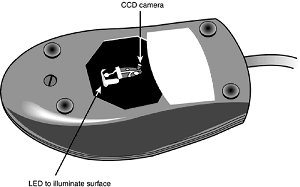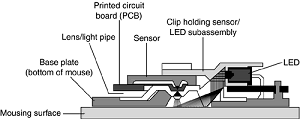Ball-Type and Optical Mice
The bottom of the mouse housing is where the detection mechanisms or electronics are located. On traditional mice, the bottom of the housing contains a small, rubber ball that rolls as you move the mouse across the tabletop. The movements of this rubber ball are translated into electrical signals transmitted to the computer across the cable.
Internally, a ball-driven mouse is very simple, too. The ball usually rests against two rollers: one for translating the x-axis movement and the other for translating the y-axis movement. These rollers are typically connected to small disks with shutters that alternately block and allow the passage of light.
Small optical sensors detect movement of the wheels by watching an internal infrared light blink on and off as the shutter wheel rotates and "chops" the light. These blinks are translated into movement along the axes. This type of setup, called an opto-mechanical mechanism, is still the most popular type of mouse mechanism, although optical mice are gaining in popularity.

Optical Mice
The other major method of motion detection is optical. Some of the early mice made by Mouse Systems and a few other vendors used a sensor that required a special grid-marked pad. Although these mice were very accurate, the need to use them with a pad caused them to fall out of favor.
Microsoft's IntelliMouse Explorer pioneered the return of optical mice. The IntelliMouse Explorer and the other new-style optical mice from Logitech and other vendors use optical technology to detect movement, and they have no moving parts of their own (except for the scroll wheel and buttons on top).
Today's optical mice need no pad; they can work on virtually any surface. This is done by upgrading the optical sensor from the simple type used in older optical mice to a more advanced CCD (charge coupled device). This essentially is a crude version of a video camera sensor that detects movement by seeing the surface move under the mouse.
An LED is used to provide light for the sensor. The IntelliMouse Explorer revolutionized the mouse industry; first Logitech, then virtually all other mouse makers, including both retail and OEM suppliers, have moved to optical mice for most of their product lines, offering a wide variety of optical mice in most price ranges.

Their versatility and low maintenance (not to mention that neat red or blue glow out the sides!) make optical mice an attractive choice, and the variety of models available from both vendors means you can have the latest optical technology for about the price of a good ball-type mouse. Figure below shows the interior of a typical optical mouse.

All optical mice have a resolution of at least 400dpi and at least one sensor. However, for better performance, some optical mice have improved on these basic features.
Optical mice, similar to traditional ball-type mice, are available as corded or cordless models. Cordless ball-type mice are usually much larger than ordinary mice because of the need to find room for both the bulky ball mechanism and batteries, but cordless optical mice are about the same size as high-end corded mice.
The cable can be any length, but it is typically between 4 and 6 feet long. Mice are also available in a cordless design, which uses either infrared or RF transceivers to replace the cable.
A receiver is plugged into the mouse port, while the battery-powered mouse contains a compatible transmitter. After the mouse is connected to your computer, it communicates with your system through the use of a device driver, which can be loaded explicitly or built into the operating system software.
For example, no separate drivers are necessary to use a mouse with Windows or OS/2, but using the mouse with most DOS-based programs requires a separate driver to be loaded from the CONFIG.SYS or AUTOEXEC.BAT file. Regardless of whether it is built in, the driver translates the electrical signals sent from the mouse into positional information and indicates the status of the buttons.
The standard mouse drivers in Windows are designed for the traditional two-button mouse or scroll mouse (in Windows Me/2000/XP or later), but increasing numbers of mice feature additional buttons, toggles, or wheels to make them more useful. These additional features require special mouse driver software supplied by the manufacturer.